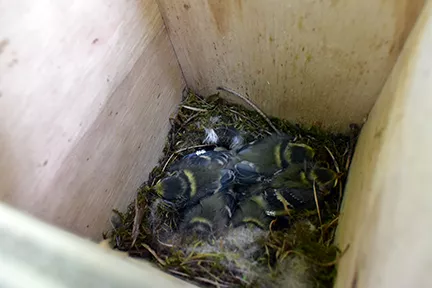“Blue Tits are quite jumpy. They can't really fly yet, when they are only two weeks old, and they don't leave the nest until a couple of days from now”, says Johan K. Jensen, PhD student at the Centre for Environmental and Climate Research (CEC), when he holds a Blue Tit to ring, measure and weigh it. In his research project he focuses on urban ecology and the differences in small birds' living conditions depending on whether they live in cities or in the countryside. The Blue Tit and Great Tit are in focus as these are widespread and well-studied birds that are also found in cities, which facilitates comparisons with rural conditions.
The increasing urbanization has increased the interest in urban ecology as a research field. Changed access to light, heat and food means that the living conditions of many species become different in cities.
“Birds in cities usually get fewer offsprings and the young birds in the cities usually weigh less. And research shows that the pigmentation of the Great Tits in the city is paler because they eat poorer food. They don’t get the same nutrients so they don’t have the same color”, says Johan K. Jensen.
Stress and sleep problems among birds
Just like modern people the birds can be affected by stress and sleep problems and need to adapt to the urban environment. Johan K. Jensen explains that pollution in the city can cause an oxidative and physiological stress on the birds and that there have been changes in the circadian rhythm of many birds, probably due to the city's artificial light.
“In some cases the birds have even changed their singing slightly to adapt to the noisy environment. Often there is also completely different access to food in the city compared to in the countryside, and how this affects the birds is something I will look into more closely during my PhD studies”, Jensen continues.
Research on how the birds are affected by climate change
In the main research project Urban Birds, which Johan K. Jensen is part of, the local climate change’s effects on birds will be examined. A warmer climate can cause the birds to lay their eggs earlier and similar, major changes in the food chain can create greater and more long-term imbalances in the ecosystem.
“There can be large differences in temperatures between the city and countryside and one of the most extreme examples is the 12 degree difference between measurements inside Tokyo compared to its surrounding countryside”, says Johan K. Jensen.
The research team has measured one degree's difference between the city of Malmö and the surrounding countryside and this difference gives a local climate in the city which e.g. may affect the availability of larvae. Jensen points out that the city's artificial light and the increasing temperature may cause the trees to burst into leaf earlier in the cities than in the countryside. This can change the timing of the greatest supply of larvae, which adapts to when there are new, fresh leaves to eat. A consequence which, in turn, can affect and bring forward the time for when the birds choose to lay their eggs since they want their young birds to have great access to larvae.
“The interactions within the field of ecology are often very complex which makes it both tricky and exciting. It is very difficult to say how an ecosystem will be affected if we remove a piece of the puzzle, e.g. a species. What we know, however, is that if we have a high diversity in an ecosystem then this ecosystem is more resilient to various changes”, Johan K. Jensen emphasizes.
Jensen hopes that the research of the team will lead to applicable and useful knowledge for decision makers, so that they can make well-informed decisions about how we should design our future cities.

